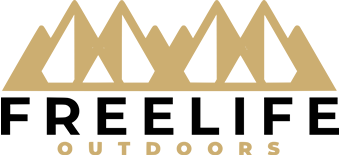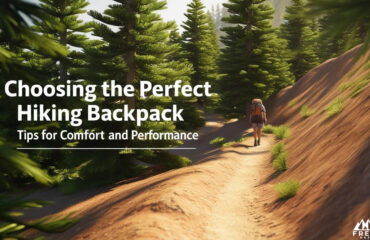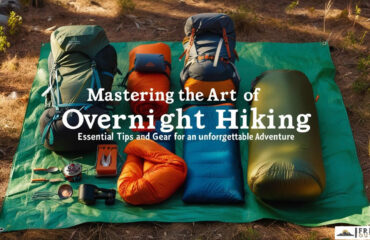
Essentials of ultra-light backpacking and minimalist gear for a more enjoyable and efficient outdoor experience.
Understanding Ultra-Light Backpacking
Ultra-light backpacking is a hiking style that prioritizes minimizing gear weight, typically aiming for a base weight of under 10 pounds. This approach allows hikers to carry only the essentials, making their journeys more enjoyable and efficient. Unlike traditional backpacking, where heavier packs can lead to fatigue and discomfort, ultra-light backpacking focuses on reducing the burden on the body while enhancing mobility. For instance, an ultra-light backpacker might swap their heavy sleeping bag for a lightweight quilt, which often provides comparable warmth with significantly less weight.
Adopting ultra-light principles involves cultivating a mindset of efficiency, resourcefulness, and adaptability. Hikers learn to critically assess each item they carry, asking themselves if it serves a dual purpose or is essential for their comfort and safety. For example, a multi-functional tool like a Swiss Army knife can replace several items in a pack, effectively reducing weight while maintaining functionality. This emphasis on minimalist gear encourages a more thoughtful approach to outdoor adventures, leading to a greater appreciation for both the journey and the environment.
Benefits of Ultra-Light Backpacking
One of the most significant benefits of ultra-light backpacking is the reduced strain on joints, which can lead to a lower risk of injury and allow hikers to enjoy their adventures well into older age. Carrying a lighter pack means less pressure on knees and hips, which is particularly important for those undertaking long hikes or challenging terrains. A lighter load facilitates longer travel distances, allowing access to secluded areas where fewer people venture, thus enhancing the experience of solitude and immersion in nature.
Moreover, the ultra-light approach fosters environmental stewardship, encouraging practices like stealth camping that minimize campsite impact and promote Leave No Trace principles. Lighter packs not only improve stamina but also simplify the packing process, making it easier to set up camp and embark on spontaneous trips. For instance, a backpacker equipped with a minimalist setup can quickly transition from hiking to camping, seizing the opportunity for an impromptu overnight adventure. Embracing ultra-light backpacking can lead to more fulfilling hiking experiences, as it allows individuals to spend more time enjoying their surroundings rather than focusing on the logistical challenges of heavy gear.
Key Principles of Minimalist Gear
The key to successful ultra-light backpacking lies in minimalist gear principles, which emphasize carrying only what is necessary to enhance the hiking experience. This principle involves critically assessing each item in your pack, determining its necessity, and eliminating anything that does not serve an essential purpose. For example, instead of packing a traditional tent, an ultra-light backpacker might choose a lightweight tarp that can double as a shelter and a ground cover, thereby reducing overall weight significantly.
Additionally, the “Big Four” – comprising your backpack, shelter, sleeping bag, and sleeping pad – are crucial areas to focus on for weight reduction. Opting for high-quality, lightweight versions of these items can drastically decrease your pack’s weight without sacrificing comfort. Regularly reassessing your gear choices based on past experiences can lead to continuous improvements in your packing strategy. For example, keeping a journal of what worked and what didn’t can help you refine your gear selection over time, making future hikes more enjoyable and efficient.
Essential Items for an Ultra-Light Backpacking Checklist
An ultra-light backpacking checklist is crucial for ensuring you have the right gear without overpacking. Recommended items often include a lightweight tent like the Gossamer Gear The One, which is celebrated for its spaciousness and minimal weight. A sleeping bag such as the Enlightened Equipment Revelation APEX is another essential, providing warmth without the bulk associated with traditional sleeping bags. Additionally, an inflatable sleeping pad like the Therm-A-Rest NeoAir UberLite can offer comfort while being incredibly light.
Safety should never be compromised, so packing a first-aid kit is essential during outdoor activities. This kit can include basic supplies like band-aids, antiseptic wipes, and any personal medications, ensuring that you are prepared for minor injuries or ailments. Moreover, including minimal hygiene items helps maintain cleanliness without adding unnecessary weight. For instance, opting for biodegradable soap and a small pack of wipes can keep your pack light while allowing for basic hygiene. A compact cooking system, like the BRS-3000T stove, can streamline meal preparation while keeping your pack light, making it easier to enjoy hot meals on the trail.
Tips for Reducing Weight Without Compromising Safety
When it comes to reducing the weight of your backpack while ensuring safety and comfort, consider using lightweight cooking gear like the Toaks alcohol stove and a titanium cook set. These items are designed to minimize weight while still offering reliable performance for meal preparation. Additionally, opting for versatile clothing, such as the Outdoor Research Helium rain jacket, provides protection from the elements without adding bulk. This jacket is lightweight yet functional, making it a popular choice among ultra-light backpackers.
Another practical tip is to switch to toothpaste tabs instead of traditional tubes; they are lighter and take up less space. This small change can have a significant impact on your overall pack weight. Furthermore, using a compact and lightweight water filtration system, like the Sawyer Squeeze filter, ensures safe hydration without adding bulk. These filters are easy to use and can fit into small spaces, making it easier to stay hydrated on long hikes. By carefully selecting your gear and clothing, you can significantly reduce your pack weight without sacrificing essential safety features.
Common Misconceptions About Ultra-Light Backpacking
There are several misconceptions surrounding ultra-light backpacking, one of which is the belief that it sacrifices comfort. In reality, the right gear choices can enhance comfort significantly. Many backpackers are surprised to find that lightweight sleeping pads and quilts can be just as cozy as their heavier counterparts, leading to a more restful night’s sleep in the great outdoors. Another common myth is that ultra-light gear is prohibitively expensive; however, many budget-conscious options, including used gear, are available for those looking to minimize costs.
Some people think that ultra-light backpacking is only suitable for experienced hikers, but beginners can also benefit from starting with balanced, lighter gear. The idea that ultra-light gear is less durable has been challenged by numerous brands that prioritize high-quality materials. Many modern ultra-light products are designed to withstand the rigors of the trail while remaining lightweight, making them suitable for both novice and experienced backpackers. Additionally, many assume that ultra-light backpacking requires significant sacrifices in functionality, whereas contemporary gear often combines lightness with usability, proving that you can have both.
Recommended Gear Brands and Products for Beginners
For those new to ultra-light backpacking, several brands stand out for their quality and lightweight options. Gossamer Gear, Waymark Gear Co., and Enlightened Equipment are frequently recommended for their reliable ultra-light products. Each of these brands offers a range of gear designed specifically for those looking to minimize weight without compromising on performance. The Nemo Switchback sleeping pad is a favorite choice for comfort and insulation, while the Therm-A-Rest NeoAir and Big Agnes brands are known for their lightweight sleeping pads and bags.
Zpacks is another company that offers a variety of high-quality lightweight backpacks and tents suitable for beginners. Their products are designed with the ultra-light backpacker’s needs in mind, ensuring that even novice hikers can find gear that meets their requirements. Outdoor Research and Sea to Summit provide a range of functional accessories that are perfect for ultra-light hiking, including lightweight backpacks and cooking gear. Investing in the right gear can significantly enhance your hiking experience and make transitioning into ultra-light backpacking smoother.
The Role of Research in Ultra-Light Backpacking
Conducting thorough trail and weather research is essential for informing gear choices and ensuring safety while backpacking. Understanding the specific conditions of the trail you’re planning to hike can help you select the most appropriate gear and prepare for any potential challenges you may face. Engaging with online resources and community guides can provide valuable insights into gear trimming and making your own equipment (MYOG). These communities often share tips, experiences, and advice that can be invaluable for newcomers and seasoned hikers alike.
Connecting with cottage manufacturers can lead to personalized gear options while supporting small businesses. This not only helps you find gear tailored to your needs but also contributes to the sustainability of the outdoor gear market. Joining online forums and social media groups focused on ultra-light backpacking can also help you learn from the experiences of others. These platforms often host discussions on gear, packing strategies, and trail experiences, providing a wealth of knowledge at your fingertips. Attending workshops or gear demos offers a chance to gain firsthand knowledge about ultra-light products and techniques, enhancing your overall understanding of this backpacking style.
Transitioning to Ultra-Light Backpacking
For those considering a shift to ultra-light backpacking, starting with a slightly heavier setup may be beneficial to understand personal needs before making the full transition. Experimenting with different gear combinations enables you to discover what works best for your style and comfort level. Gradually reducing weight as experience and comfort levels grow is a practical strategy for ensuring a positive experience. For example, if you find that certain items are unnecessary on a hike, you can begin to eliminate them from your pack on future trips.
Keeping a journal to track gear performance and preferences over time can also aid in refining your packing strategy. Noting what gear worked well and what didn’t during your trips allows for thoughtful adjustments in future outings. Partnering with experienced ultra-light backpackers for mentorship can provide invaluable advice on gear selection and packing strategies. This supportive approach helps newcomers learn the ropes while feeling confident in their gear and decisions on the trail.
Embracing the Ultra-Light Backpacking Experience
Embracing the ultra-light backpacking lifestyle can lead to more fulfilling adventures and a deeper appreciation of nature. This approach encourages you to engage with your surroundings more fully, as you are less encumbered by heavy gear and can move more freely. The community aspect of ultra-light backpacking fosters shared knowledge and support among hikers, creating a sense of camaraderie among those who enjoy the trails together. Participating in local hiking groups or events can help you build these connections and expand your hiking experience.
Ultimately, ultra-light backpacking can transform the way you experience the great outdoors, allowing for greater exploration and enjoyment of nature’s beauty. With the right mindset and gear, you can embark on adventures that not only challenge you physically but also enrich your connection with the environment. By adopting an ultra-light approach, you open yourself up to new experiences and a lifestyle that celebrates both simplicity and the joy of nature.



